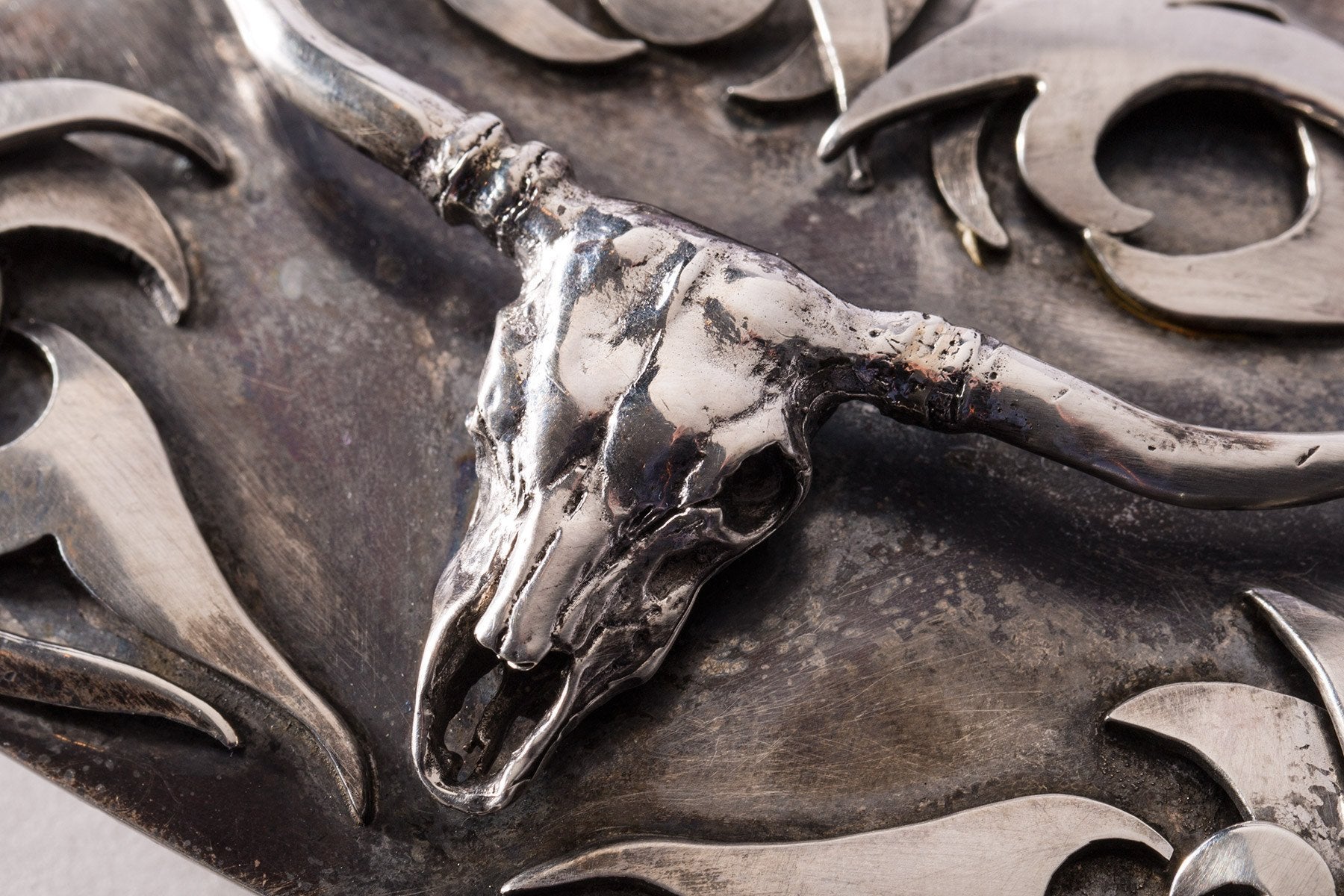When James Stegman asked for his father’s blessing to branch off from the family-owned Comstock Silversmiths and re-christen the Comstock Heritage brand, he had one thing in mind.
Or rather he had several things in mind, and one goal—giving form to the swarm of creative visions in his head. The way he tells it, he landed on silversmithing as his medium simply because it was accessible. His family has worked in the trade for generations, so he had access to the tools and materials of a silversmith. Simple as that.
One gets the sense that if the Stegman family had owned a paint business, we’d have had the next great American painter on our hands. Because as much as James is a silversmith—and make no mistake, his credentials are unimpeachable—he is even more so an artist. The levels of meaning he works into every layer of his creations are on par with anything you’ll see in an art gallery. The only difference is that James’ art is wearable.
If James did not choose his medium, perhaps it chose him. The two are so perfectly suited for one another that the ‘chance’ connection of his family heritage looks like providence. Recently, for a different post, we described the unique nature of belt buckles as such: Belt buckles are special items. They aren’t quite what comes to mind when you think of jewelry, but neither are they simple accessories. Buckles are a unique way to express your style and accent your look, and they are a one-of-a-kind heirloom piece to pass down through the generations. Perhaps a traditional Western silversmith using century-old tools handmade by his grandfather isn’t what comes to mind when you imagine a world-class artist, but that's exactly what Stegman is.
James has said before that he loves to be underestimated (it’s no coincidence that his workshop resembles an old-time speakeasy). His buckles reflect this preference; in some, the use of understatement borders on irony. The “Tribal Longhorn” buckle is a typical example.
Its motif, a longhorn skull, looks relatively simple at first glance. It appears to be made of bronze, along with portions of the ‘tribal’ bordering. In truth, that bronzy metal is actually a heavily burnished 14k rose gold. The skull, upon closer inspection, reveals remarkable detailing. Its shading and wear-marks (painstakingly traced and engraved by hand) look so natural that they may go unnoticed, but collectively they effect a vivid likeness of weatherworn bone. James estimates that the skull alone took eight hours to make.
The Tribal Longhorn buckle also reflects Comstock’s overarching aesthetic. As a Western silversmith by heritage, James often works with Western themes—such as the longhorn skull—but he loves to explore other genres, often interpreting them through an Americana lens (or vice versa). Hence the buckle’s ‘tribal’ bordering. A friend once suggested getting a tribal tattoo; James politely declined, but the idea stuck—wouldn’t that look interesting in a Western theme? These are the signs of a genuine artist: the eye for patterns unseen by others, the hand creating new meaning from old matter.
Like any good artist, James leaves some questions unanswered. Why spend so much time on imperceptible details? Why etch and shade precious metals to look like bronze or iron? Who knows. Maybe James has the answers, but ask him and you’re more likely to receive a friendly smile and self-effacing joke. Artists always seem to reside somewhere between enigmatically profound and blithely crazy.
Here’s our guess—luxury is in the details that you can enjoy without caring if others notice.
When James Stegman asked for his father’s blessing to branch off from the family-owned Comstock Silversmiths and re-christen the Comstock Heritage brand, he had one thing in mind.
Or rather he had several things in mind, and one goal—giving form to the swarm of creative visions in his head. The way he tells it, he landed on silversmithing as his medium simply because it was accessible. His family has worked in the trade for generations, so he had access to the tools and materials of a silversmith. Simple as that.
One gets the sense that if the Stegman family had owned a paint business, we’d have had the next great American painter on our hands. Because as much as James is a silversmith—and make no mistake, his credentials are unimpeachable—he is even more so an artist. The levels of meaning he works into every layer of his creations are on par with anything you’ll see in an art gallery. The only difference is that James’ art is wearable.
If James did not choose his medium, perhaps it chose him. The two are so perfectly suited for one another that the ‘chance’ connection of his family heritage looks like providence. Recently, for a different post, we described the unique nature of belt buckles as such: Belt buckles are special items. They aren’t quite what comes to mind when you think of jewelry, but neither are they simple accessories. Buckles are a unique way to express your style and accent your look, and they are a one-of-a-kind heirloom piece to pass down through the generations. Perhaps a traditional Western silversmith using century-old tools handmade by his grandfather isn’t what comes to mind when you imagine a world-class artist, but that's exactly what Stegman is.
James has said before that he loves to be underestimated (it’s no coincidence that his workshop resembles an old-time speakeasy). His buckles reflect this preference; in some, the use of understatement borders on irony. The “Tribal Longhorn” buckle is a typical example.
Its motif, a longhorn skull, looks relatively simple at first glance. It appears to be made of bronze, along with portions of the ‘tribal’ bordering. In truth, that bronzy metal is actually a heavily burnished 14k rose gold. The skull, upon closer inspection, reveals remarkable detailing. Its shading and wear-marks (painstakingly traced and engraved by hand) look so natural that they may go unnoticed, but collectively they effect a vivid likeness of weatherworn bone. James estimates that the skull alone took eight hours to make.
The Tribal Longhorn buckle also reflects Comstock’s overarching aesthetic. As a Western silversmith by heritage, James often works with Western themes—such as the longhorn skull—but he loves to explore other genres, often interpreting them through an Americana lens (or vice versa). Hence the buckle’s ‘tribal’ bordering. A friend once suggested getting a tribal tattoo; James politely declined, but the idea stuck—wouldn’t that look interesting in a Western theme? These are the signs of a genuine artist: the eye for patterns unseen by others, the hand creating new meaning from old matter.
Like any good artist, James leaves some questions unanswered. Why spend so much time on imperceptible details? Why etch and shade precious metals to look like bronze or iron? Who knows. Maybe James has the answers, but ask him and you’re more likely to receive a friendly smile and self-effacing joke. Artists always seem to reside somewhere between enigmatically profound and blithely crazy.
Here’s our guess—luxury is in the details that you can enjoy without caring if others notice.


